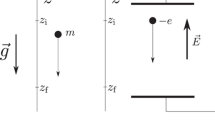Abstract.
We present a new separated beam atom interferometer in which the recombination of the atomic wave packet is due to the dc-Stark interaction of an induced atomic dipole with a cylindrically symmetric electric field of a charged wire. The fringe period shows a weak power-law dependence on the de Broglie wavelength and the polarizability of the particles. We present a semiclassical theoretical model for this interferometer which resembles the measured performance of the interferometer without free parameters. A discussion of possible applications of this interferometer for atoms and molecules is given.
Similar content being viewed by others
Author information
Authors and Affiliations
Additional information
Received: 20 November 1998 / Published online: 8 September 1999
Rights and permissions
About this article
Cite this article
Nowak, S., Pfau, T. & Mlynek, J. A matter-wave interferometer based on the dc-Stark effect. Appl Phys B 69, 269–275 (1999). https://doi.org/10.1007/s003400050807
Published:
Issue Date:
DOI: https://doi.org/10.1007/s003400050807




